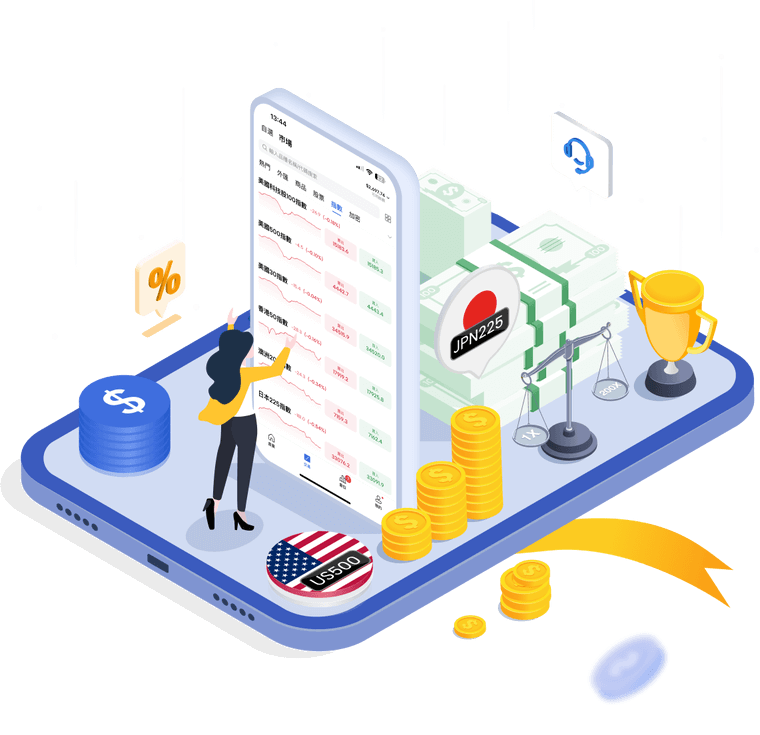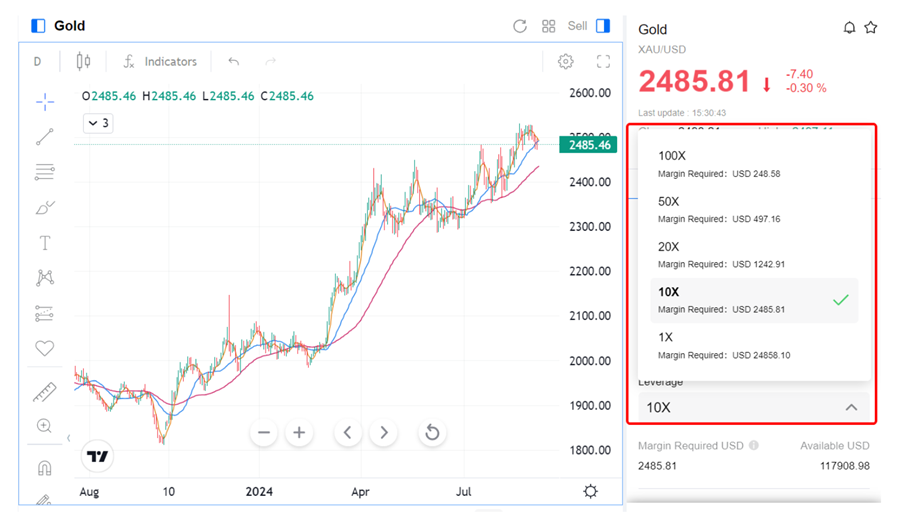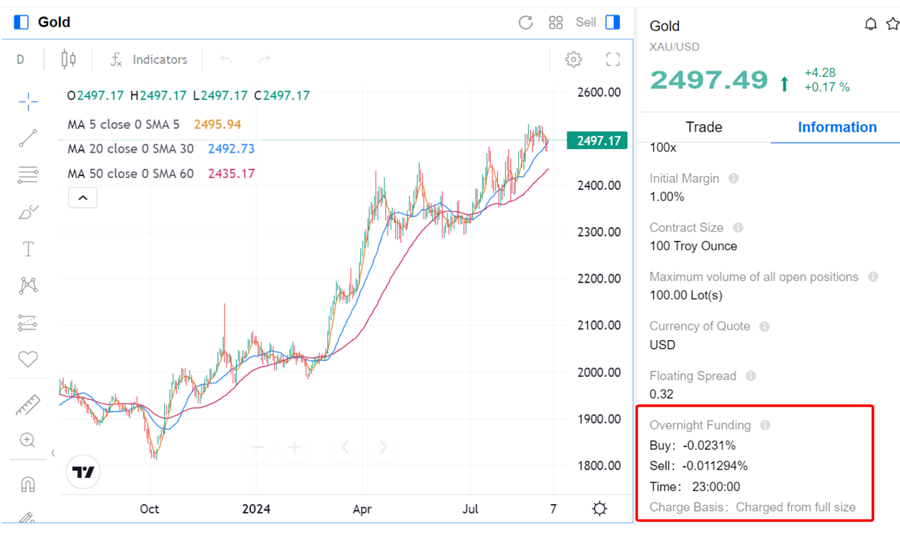
Leverage is a fundamental concept in financial trading,allowing traders to control larger positions with a smaller amount of capital. While it can amplify potential profits, leverage also significantly increases the risk of losses, making it a powerful but double-edged sword.
This article delves into the mechanics of leverage, exploring how it works, the benefits and dangers it presents, and how traders can use it effectively. Whether you're just starting out as a trader or have years of experience as an investor, grasping the concept of leverage is essential for successfully managing the intricacies of the financial markets.
1. What is Leverage in Financial Trading?
Leverage in financial trading is a technique that allows traders to manage a larger market position with only a small portion of their own capital. To enhance the potential return on investment, traders achieve this by borrowing funds from a broker. However, although leverage can enhance gains, it also significantly increases the risk of losses, necessitating careful application.
The pros and cons of using leverage in financial trading:
Pros of Leverage | Cons of Leverage |
Amplified profits: Leverage can significantly increase potential returns on investment. | Increased risk: Losses can also be magnified, potentially exceeding the initial investment. |
Access to larger positions: Allows traders to control larger positions in the market with less capital. | Margin calls: If the market moves against a leveraged position, brokers may issue margin calls, requiring additional funds to maintain the position. |
Capital efficiency: Frees up capital for other investments or trades, as less personal capital is required. | Complexity: Managing leveraged positions can be more complex and requires a deeper understanding of the markets. |
Potential for diversification: Enables traders to diversify their portfolios without needing a large amount of capital. | Interest costs: Borrowing funds from a broker typically incurs interest, which can reduce overall profitability. |
Opportunity in volatile markets: Leverage can enhance gains during periods of high market volatility. | Emotional stress: The high stakes involved in leveraged trading can lead to significant emotional stress and impulsive decision-making. |
The importance of understanding leverage:
Magnifies risk and reward: Leverage amplifies both potential profits and losses, making it crucial to understand how it affects your trades.
Requires risk management: Essential for setting stop-loss orders and monitoring margin levels to prevent significant losses.
Affects trading decisions:This influences the way you size positions and manage trades, which in turn influences your overall strategy.
Avoids margin calls: Helps you maintain sufficient margin to avoid margin calls and forced liquidation of positions.
Prevents overleveraging: Understanding leverage prevents taking on excessive risk that can lead to severe losses.
Enhances financial literacy: Improves your overall understanding of financial markets and trading strategies.
Supports better planning: Enables more effective trade planning and execution aligned with your risk tolerance and financial goals.
Types of Leverage: In financial trading, leverage can be accessed through margin trading and derivatives. Margin trading allows traders to borrow funds from a broker to amplify their market exposure. For example, with 10:1 leverage, a trader can control $10,000 in assets with just $1,000.
Derivatives like futures, options, and CFDs also offer leverage, enabling traders to control large positions with a small upfront investment. For instance, futures contracts allow traders to speculate on commodity prices with only a fraction of the asset’s total value, but both profits and losses are magnified.

 0 commission, low spreads
0 commission, low spreads Diverse risk management tools
Diverse risk management tools Flexible leverages and instant analysis
Flexible leverages and instant analysis Practice with $50,000 risk-free virtual money
Practice with $50,000 risk-free virtual money 
A clear grasp of how leverage works helps traders make informed decisions, set appropriate risk management strategies, and avoid common pitfalls that could lead to significant financial losses. This content will be explored further in the next section.
2. How Does Leverage Work?
By borrowing funds from a broker, leverage enables traders to manage a substantial market position using only a small portion of their own capital. The margin, which acts as collateral for the borrowed funds, is the amount of capital required to open and maintain a leveraged position. . Here’s a detailed breakdown of how leverage operates, with examples to illustrate its impact:
Leverage Ratio
The leverage ratio indicates how much larger a position you can control compared to your own capital. It’s expressed as a ratio, such as 1:1, 5:1 (5X), 10:1 (10X) or 200:1 (200X). This ratio determines how much of the market exposure you can achieve with a given amount of margin.
Example:

Gold price chart (Source: Mitrade)
Suppose you want to trade 0.1 lot of gold at a price of $2,485.81 per ounce, using a leverage of 10:1. This means that for every $1 of your own capital, you can control $10 worth of gold in the market.
Opening a Leveraged Position
When you use leverage, you only need to deposit the margin amount to open a position. The broker provides the rest of the funds needed to take on the full position size.
Example: If you want to buy 100 shares of Tesla (TSLA) priced at $212 each, the total value of your position would be $21,200 (100 shares x $212). With a 20:1 leverage ratio, you would only need to deposit $1060 as a margin ($21,200 / 20). The broker covers the remaining $20,140.
Margin Requirements and Margin Calls
Apart from the deposit required to open a leveraged position, known as the initial margin, a trader also needs to maintain a certain amount to keep the position active, referred to as the maintenance margin. If your account equity falls below this level due to adverse market movements, the broker may issue a margin call. A margin call necessitates that you deposit additional funds into your account to restore the margin level or close some positions to reduce your exposure.
Example: Let’s go back to the example of trading gold above.
Initial margin
= Contract value of the open position at opening price * Initial Margin Ratio %
= Opening Price x Number of Lots x Contract Size x Initial Margin %
Maintenance margin (Using the ratio is 50% of initial margin)
= Contract value of open position at opening price * Maintenance Margin Ratio %
= Opening Price x Number of Lots x Contract Size x Initial Margin %* 50%
If you buy 0.1 lot of Gold at the price of $2,485.81 with leverage 1:10
Item | Calculation | Value |
Contract Size | Given | 100 Troy Ounces |
Position Size | 0.1 lot * 100 Troy Ounces | 10 Troy Ounces |
Opening Price per Ounce | Given | $2,485.81 |
Contract Value at Opening | $2,485.81 * 10 Troy Ounces | $24,858.10 |
Leverage | Given | 10:1 (10X) |
Initial Margin Ratio | Given | 10% |
Initial Margin | $24,858.10 * 10% | $2,485.81 |
Maintenance Margin Ratio | 10% * 50% | 5.00% |
Maintenance Margin | $24,858.10 * 5% | $1,242.91 |
If the gold price falls and the value of your position drops below $1,242.91, your broker might require you to deposit additional funds to cover the losses and maintain the position. If you fail to meet the margin call, the broker might automatically close your position to prevent further losses.
Overnight funding
When using leverage, traders should also be aware of overnight funding costs, often referred to as swap rates. These are fees or interest charges incurred for holding leveraged positions overnight. The cost of maintaining such positions can vary depending on the broker, the products, and the direction of the trade (long or short). It's important to factor in these costs, as they can impact the overall profitability of a trade.
For example:

The overnight funding cost for a buying position in gold is 0.0231%, while the cost for a selling position is 0.011294%. (Source: Mitrade)
Profit and Loss Calculation
The potential profit or loss from a leveraged trade is calculated based on the full value of the position, not just the margin.
Example: Let’s continue with the gold example. Suppose you hold the position for 2 days and close it when the price reaches $2,510.00:
Item | Calculation | Value |
Overnight Funding (Buying) | $24,858.10 * 0.0231% * 2 days | $11.48 |
Profit (Buying) | ($2,510.00 - $2,485.81)*10 Troy Ounces | $242.19 |
Net Profit/Loss (Buying) | Profit - Funding Costs (Buying) | $230.71 |
Note: High leverage ratios can significantly increase both potential gains and potential losses. While this can lead to substantial profits if the market moves in your favor, it also means that even small adverse price movements can lead to significant losses.
3. How to Manage Leverage Effectively
Effectively managing leverage is key to successful trading, as it helps to balance potential gains with the risks involved.Here are a few guidelines for effectively managing leverage:
Set appropriate leverage levels: Choose a leverage level that aligns with your risk tolerance and trading goals. Avoid using the maximum leverage offered by brokers, as this can expose you to excessive risk.
Use stop-loss orders: Implement stop-loss orders to automatically close a position if the market moves against you. This aids in limiting potential losses and shields your account from catastrophic market movements.
Monitor margin requirements: Keep a close eye on your margin level to avoid margin calls, which require additional funds to maintain your positions. Regularly review your account balance and adjust your positions as necessary.
Avoid overleveraging: Be cautious about taking on too many leveraged positions at once. Overleveraging can lead to significant losses if the market moves unexpectedly.
Stay informed: Keep up-to-date with market conditions and news that could impact your trades. Understanding the broader market context will help you make more informed decisions when using leverage.
Practice risk management: Diversify your portfolio to spread risk across different assets and avoid putting all your capital into a single leveraged trade. This can help reduce the overall impact of a single loss on your account.
By implementing these strategies, you can use leverage more effectively, maximizing its benefits while minimizing the associated risks.
4. Summary
In financial trading, leverage is a powerful tool that enables traders to control larger market positions with a smaller initial investment.. While it can significantly amplify potential profits, it also comes with the risk of magnified losses.
Understanding how leverage works and managing it effectively through strategies like using stop-loss orders, maintaining adequate margins, and starting with lower leverage ratios are crucial for successful trading. Use leverage carefully and responsibly to prevent severe financial consequences.
Before making any trading decisions, it is important to equip yourself with sufficient fundamental knowledge, have a comprehensive understanding of market trends, be aware of risks and hidden costs, carefully consider investment targets, level of experience, risk appetite, and seek professional advice if necessary.
Furthermore, the content of this article is solely the author's personal opinion and does not necessarily constitute investment advice. The content of this article is for reference purposes only, and readers should not use this article as a basis for any investment decisions.
Investors should not rely on this information as a substitute for independent judgment or make decisions solely based on this information. It does not constitute any trading activity and does not guarantee any profits in trading.
If you have any inquiries regarding the data, information, or content related to Mitrade in this article, please contact us via email: insights@mitrade.com. The Mitrade team will carefully review the content to continue improving the quality of the article.












